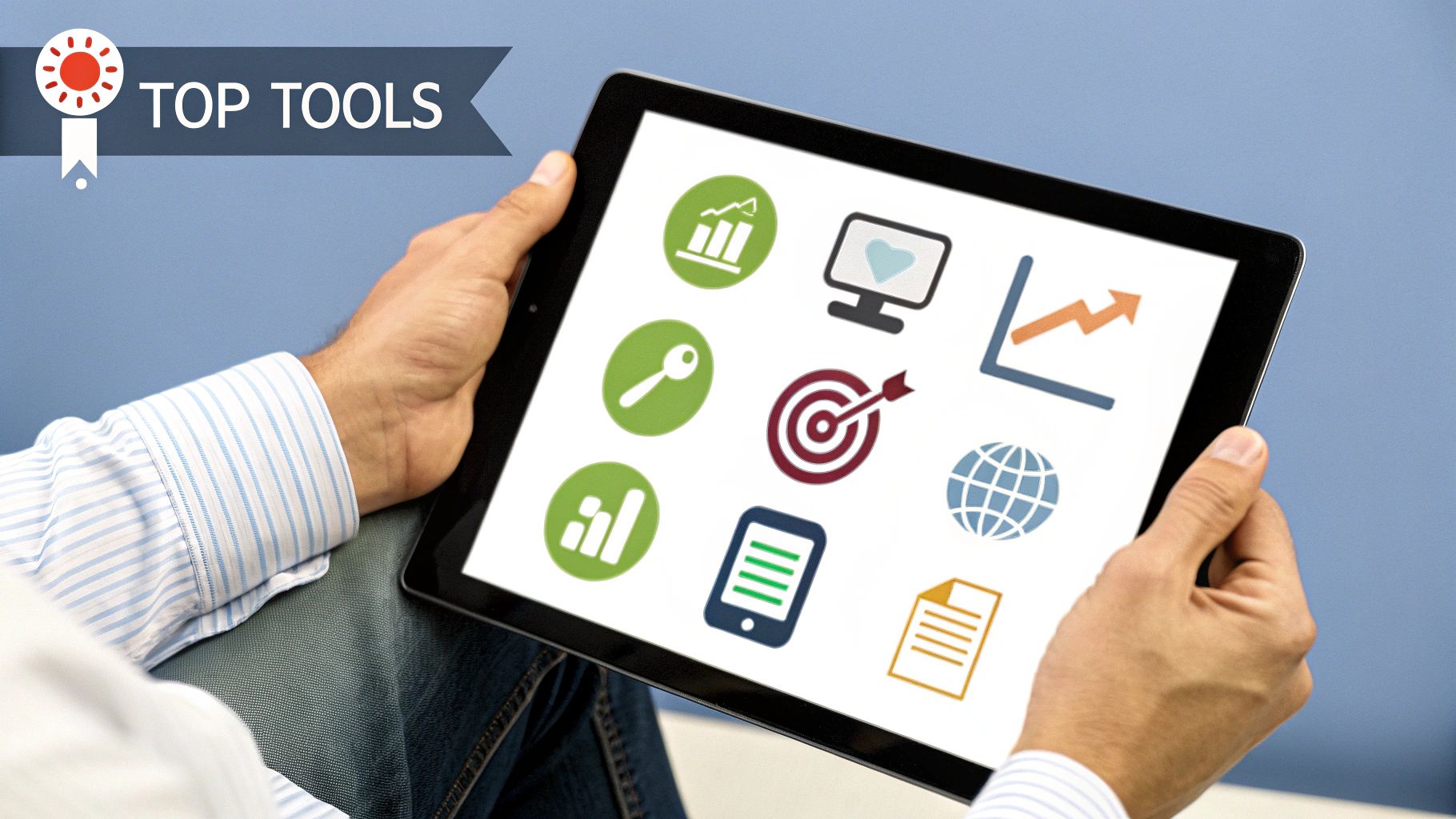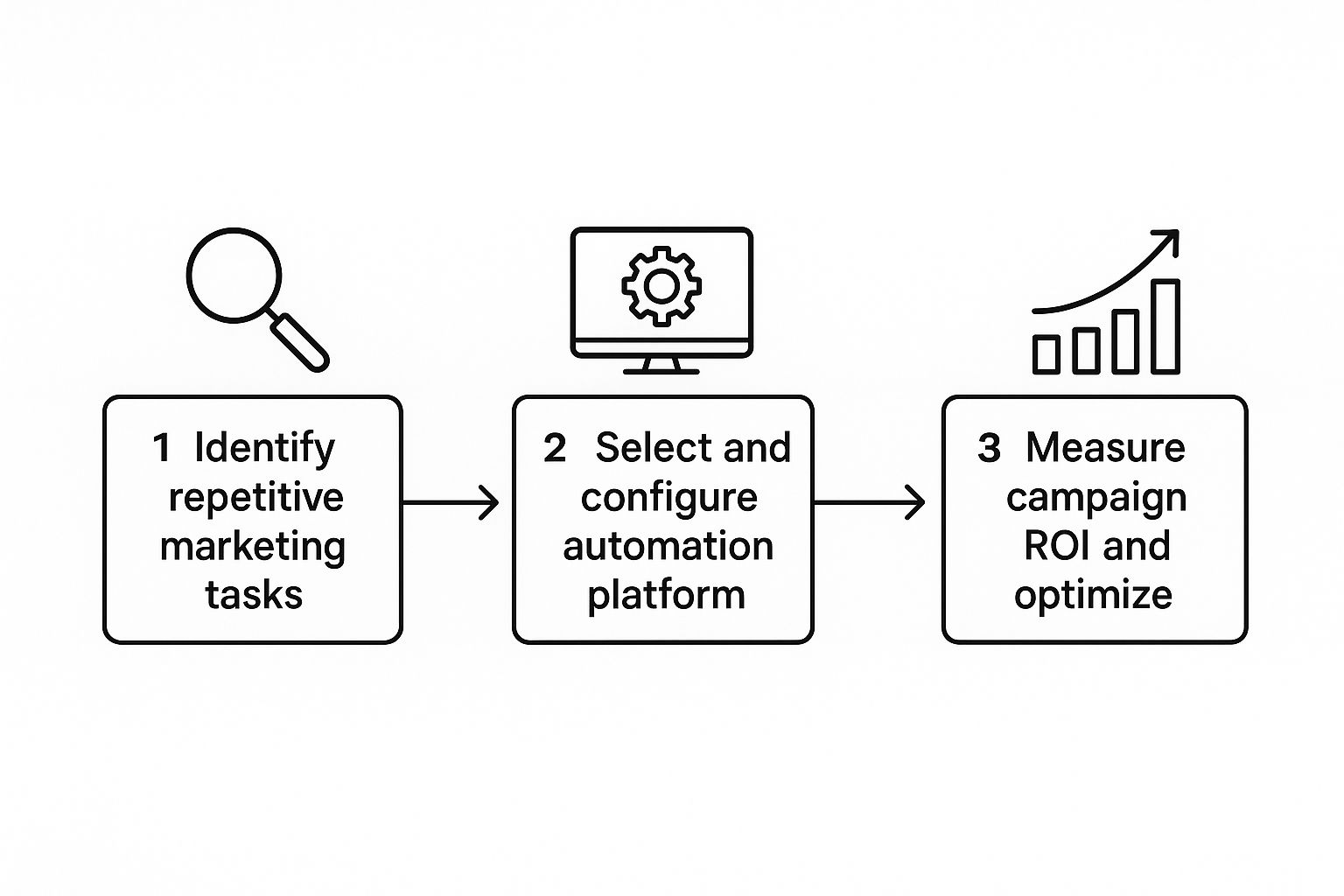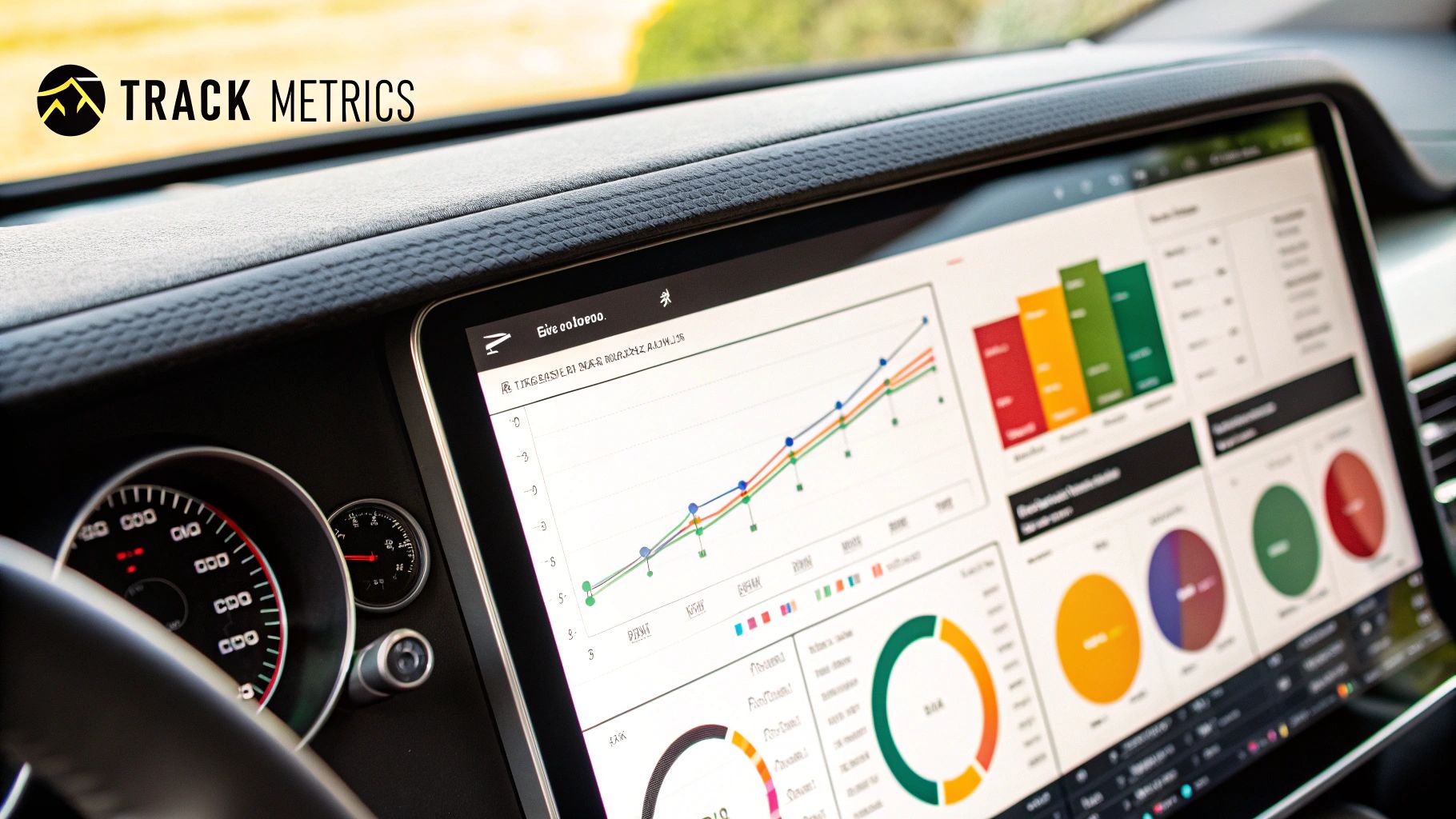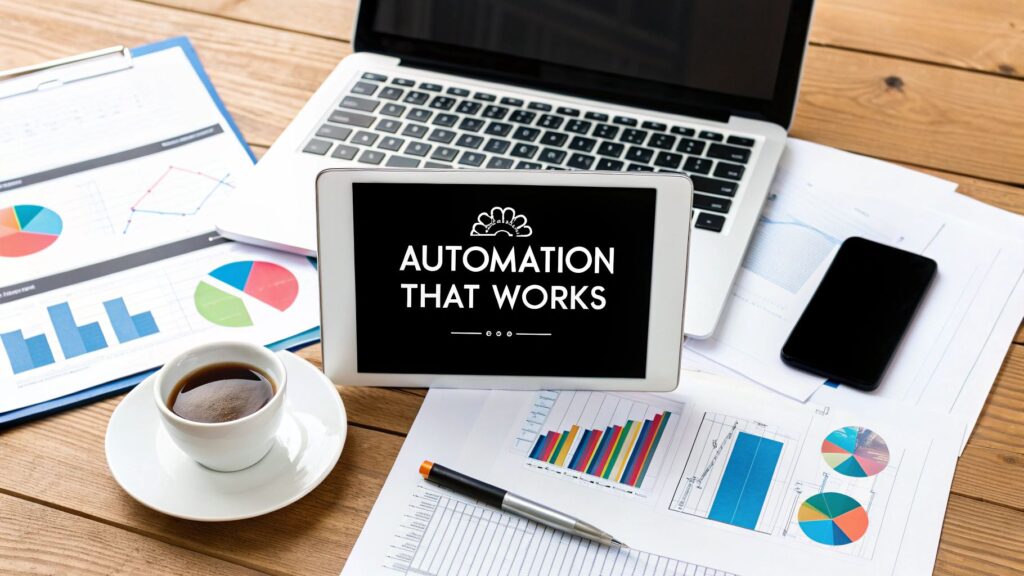Picture this: you have an assistant working around the clock, handling all your repetitive marketing tasks without ever needing a break. That’s the real promise of small business marketing automation. It’s no longer some complicated, expensive toy for huge corporations; it's a game-changing—and accessible—strategy for UK SMEs serious about growth.
What Is Marketing Automation and Why It Matters Now
At its heart, marketing automation is simply using software to take care of marketing jobs you’d otherwise have to do by hand. Think of it as setting up a series of "if this, then that" commands for your marketing. For instance, if a visitor signs up for your newsletter, the system automatically sends off a welcome email.
This technology becomes a core part of your digital team, executing routine tasks with perfect precision. It frees you from the drudgery of sending follow-up emails, scheduling social media posts, or manually sorting customer lists. Suddenly, you have more time to focus on the bigger picture—strategy, creativity, and building real relationships with your customers.
From Manual Grind to Automated Impact
If you’re a busy small business owner, the "why" is simple and powerful. It’s about getting your most precious resource back: your time. But the benefits run deeper than just being more efficient. It’s about giving your customers a far better, more consistent experience—something that’s practically impossible to manage by hand once your business starts to take off.
So, why is automation a must-have for small businesses today?
- Systematic Lead Nurturing: It carefully guides potential customers from being mildly interested to ready to buy, using a series of well-timed, relevant messages. No lead is ever forgotten or slips through the cracks.
- Personalised Communication at Scale: You can send messages tailored to different customer groups based on their behaviour or interests. This makes your marketing feel less like a blanket broadcast and more like a one-to-one conversation.
- Building Stronger Relationships: By delivering the right message at the right moment—like a thank-you note after a purchase or a special offer on a customer's birthday—you build loyalty that lasts.
People often think automation makes marketing cold and impersonal. When you get it right, it does the complete opposite. It gives you the power to create highly personalised experiences for every single customer—a feat you could never achieve manually.
A Growing Trend in the UK
This move away from manual marketing isn't just a theory; it’s happening right now across the UK. A major shift is underway, with around 45% of UK small and medium enterprises now using at least one AI-powered tool. That’s a huge jump from just 25% two years ago, and for medium-sized businesses, the figure climbs to 65%. You can dig into these survey insights on AI adoption at ProfileTree.com. The numbers don't lie: your competitors are almost certainly using these tools to work smarter and get ahead.
The Real-World Benefits of Automating Your Marketing

While saving time is a fantastic perk, the true power of small business marketing automation lies in the tangible, commercial advantages it brings. It's about building a robust engine for growth that keeps working for you, even when you’re busy running your business.
Think of it like this: every single person who shows a glimmer of interest in what you do is a potential customer. As your business grows, trying to manually track every interaction becomes an impossible task. This is where automation acts as a safety net, ensuring no one gets forgotten and every lead is guided with consistent, helpful communication.
Supercharge Your Lead Generation and Sales
One of the first things you'll notice is a dramatic improvement in how you handle new leads. Instead of potential customers slipping away because you were too swamped to follow up, an automated system gives them a prompt and professional response every single time.
Imagine a potential client fills out a form on your website at 10 PM. With automation, they can instantly receive a thank-you email with some useful information, confirming you've got their enquiry. That immediate acknowledgement builds trust and keeps your business top of mind, making it far more likely you'll turn that interest into a sale.
An automated follow-up system is like having your best salesperson on duty 24/7. It doesn’t just respond; it starts building a relationship from the very first interaction, ensuring every potential customer feels valued and heard.
This level of consistency can transform your lead generation process from a leaky bucket into a well-oiled pipeline. In fact, research shows that B2B marketers who use automation can boost their sales pipeline contribution by an average of 10%.
Drive Revenue with Personalised Campaigns
Let's be honest, generic marketing messages are easy to ignore. Automation gives you the tools to create highly personalised campaigns that speak directly to what your customers actually care about. This doesn't just drive initial sales; it builds the foundation for valuable repeat business.
For example, an e-commerce store can automatically send a follow-up email showcasing related products after a customer makes a purchase. Or a local service provider could send a simple birthday discount to clients in their database. It’s this personal touch that makes customers feel seen and understood—a crucial ingredient for building a loyal following.
The financial impact is hard to ignore. For UK small businesses, email marketing is a powerhouse, and its effectiveness skyrockets when you add automation. Across various UK industries, email marketing generates an average return on investment (ROI) of £42 for every £1 spent. What's more, automation can help trim marketing overheads by about 12.2%, making every pound in your budget work that much harder. You can dig deeper into these marketing automation statistics and their impact on findstack.com.
Enhance Customer Loyalty and Retention
We all know it costs far more to attract a new customer than to keep an existing one. Marketing automation is your secret weapon here, helping you deliver the right message at the right time to build genuine, lasting loyalty.
Consider these simple but effective automated touchpoints that foster strong relationships:
- Onboarding Sequences: A friendly series of welcome emails can introduce new customers to your brand, share tips on using your product, and make them feel part of your community.
- Feedback Requests: Why not automatically ask for a review a week after a purchase? It shows you value their opinion and provides you with priceless social proof.
- Re-engagement Campaigns: If a customer hasn't bought anything in a while, a friendly, automated email with a small special offer can be just the nudge they need to come back.
These thoughtful interactions demonstrate that you care about your customers beyond the initial transaction. They create a superior experience that can turn one-time buyers into lifelong advocates for your brand. This systematic, caring approach is one of the core benefits you'll get from embracing small business marketing automation.
How to Build Your First Automation Strategy

Dipping your toes into small business marketing automation can feel a bit daunting, like you’re about to assemble a complex engine without a manual. But honestly, building your first strategy is far more straightforward than you might think. It’s less about technical wizardry and much more about common sense—thinking through your customer's journey and setting up simple, helpful interactions along the way.
The trick is to start small and be crystal clear about what you want to achieve. Before you even look at any software, your first job is to decide on your destination. A vague goal like "get more customers" just won't cut it. You need clear, measurable objectives to guide every decision you make.
Define Clear and Measurable Goals
Think of your goals as the destination you’re plugging into your GPS. Without a clear endpoint, you’ll just be driving aimlessly. Your automation strategy needs that same sense of direction if it's going to work and deliver a real return on your investment.
These goals need to be specific and quantifiable. For instance:
- Increase online sales by 15% over the next quarter.
- Generate 20 new qualified leads per month from our website contact form.
- Boost repeat purchases from existing customers by 10% within six months.
- Reduce abandoned carts by 25% through automated reminders.
Setting these kinds of targets gives you a benchmark for success. You’ll know exactly what you’re working towards and can easily check if your automations are actually doing their job. This data-first approach takes the guesswork out of the equation and helps you justify the time and money you put in.
Understand Your Ideal Customer
Right, so you know what you want to achieve. The next step is to get laser-focused on who you're trying to reach. You need a rock-solid picture of your ideal customer, and I don't just mean their age or location. It’s about truly understanding their motivations, their problems, and what they need from a business like yours.
A great automation strategy doesn't just send messages; it delivers solutions. By deeply understanding your customer’s pain points and journey, you can create automated communications that feel genuinely helpful and personal, not robotic.
To build this profile, start asking the important questions:
- What are their biggest challenges related to what you sell?
- What information do they need before they feel confident enough to buy?
- Where do they hang out online? Is it social media, industry forums, or are they mainly on email?
Getting this right is the foundation for creating messages that actually land. After all, you wouldn't speak to a busy tradesperson the same way you’d speak to a fashion-conscious online shopper. Tailoring your approach starts with knowing exactly who is on the other end.
Map the Customer Journey and Create Workflows
With your goals set and your customer in mind, it's time to map out their journey. This is where you connect the dots, from the moment a potential customer first hears about you to the point they become a loyal fan who tells their friends. A customer journey map simply outlines every key touchpoint.
For a small business, this map doesn't need to be some epic, complicated document. It could be as simple as this:
- Awareness: Someone stumbles upon your business through a social media post or a Google search.
- Consideration: They pop over to your website and sign up for your newsletter to find out more.
- Conversion: They make their first purchase. Hooray!
- Loyalty: They get a thank-you email and, a bit later, an offer for a discount on their next purchase.
- Advocacy: They’re so happy they leave a glowing review and recommend you to a friend.
Your automations, or workflows, are the automated actions you build around these touchpoints. A workflow is just a sequence of simple "if this happens, then do that" rules.
Scenario for a UK E-commerce Store:
- Trigger (If this): A customer adds items to their cart but leaves the website without checking out.
- Workflow (Then that):
- Action 1 (Wait 1 hour): Send an email reminder: "Did you forget something?"
- Action 2 (Wait 24 hours): If they still haven't bought, send a second email with a limited-time 10% discount code to nudge them over the line.
- Action 3 (Stop): As soon as a purchase is made, the customer is removed from this workflow.
This simple abandoned cart sequence can claw back a serious amount of lost revenue, all without you lifting a finger. By starting with clear goals and focusing on one or two high-impact workflows like this, you can build a powerful automation engine one step at a time.
Essential Automation Workflows For Immediate Impact
Bridging the gap between planning and performance doesn’t have to be overwhelming. By zeroing in on a handful of high-impact workflows, you’ll land quick wins and build momentum from day one.
Think of these sequences as the chart-toppers on your greatest hits album—each one tried, tested, and ready to move the needle.

Success in small business marketing automation often follows a simple loop: identify a repeatable task, craft the workflow, measure the outcome, and then fine-tune.
The Welcoming Handshake: Welcome Series
Your welcome series is like greeting a visitor at your door. The moment someone subscribes, they should feel noticed and appreciated.
- Email 1 (Immediate): A warm thank-you, confirmation of their sign-up, and a reminder of what’s in store.
- Email 2 (Day 2): Share your brand story—why you exist and what sets you apart.
- Email 3 (Day 4): Highlight your top-performing products or posts to guide new subscribers toward value.
This gentle introduction turns casual newcomers into engaged community members.
The Gentle Guide: Lead Nurturing
Not every prospect is ready to buy on first contact. A lead nurturing workflow steps in as a patient guide, sharing insights until they feel confident to commit.
Lead nurturing isn’t about pushing for a sale; it’s about earning trust.
For example, if someone downloads your guide on “Choosing the Right Kitchen Tiles,” follow up with:
- Customer case studies that show real-life solutions
- Practical design tips to inspire their next project
- A soft invitation to book a free consultation
Each touchpoint educates and positions you as the expert.
The Thank You Note: Customer Loyalty
The sale isn’t the finale—it’s just the opening act. A loyalty workflow thanks customers for their business and gives them a reason to return.
One London bakery used this approach—triggering personalised emails based on purchase history—and achieved a 30% increase in repeat sales in one year. Read more about how UK SMEs are boosting efficiency with digital marketing at Validus Media.
The Friendly Nudge: Re-engagement Campaign
Over time, some subscribers will go quiet. A re-engagement sequence is your chance to remind them why they signed up in the first place.
- Trigger: No opens or visits for 90 days.
- Step 1: Send a “We’ve missed you” email to spark curiosity.
- Step 2: If there’s no response, follow up with a time-sensitive offer.
- Step 3: Tag inactive contacts for pruning to keep your list healthy.
Here’s a quick reference to help you map out these core workflows:
Essential Automation Workflow Examples
A breakdown of common automation workflows, their purpose, and key components to help small businesses get started.
| Workflow Type | Business Goal | Example Trigger | Example Action Sequence |
|---|---|---|---|
| Welcome Series | Build initial engagement | New subscriber sign-up | Send thank-you; share brand story; highlight top content |
| Lead Nurturing | Educate and build trust | Free guide download | Send tips; case study; consultation invite |
| Customer Loyalty | Encourage repeat purchases | First purchase completed | Send thank-you; recommend related products; offer exclusive discount |
| Re-engagement Campaign | Reactivate dormant contacts | No interaction for 90 days | Send “miss you” email; offer special deal; tag inactive for list clean |
Rolling out these four workflows covers every stage of your customer journey. Start here to build a solid foundation before moving on to more advanced automation.
Choosing the Right Marketing Automation Tool

Diving into the world of small business marketing automation can feel a lot like walking into a massive superstore when you only need a handful of things. With countless platforms all promising the moon, it’s far too easy to get bogged down in technical jargon and overwhelming feature lists.
The secret isn’t to find the platform with the most bells and whistles. It’s about finding the one that truly fits your business right now, while giving you a bit of room to grow. For most small businesses in the UK, the choice really comes down to a few practical, common-sense factors.
Key Factors for Your Decision
Before you even glance at a comparison table, it’s worth taking a moment to look inward at your own business. Getting crystal clear on these four areas will make your final decision much simpler and stop you from paying for powerful features you’ll never actually touch.
- Your Budget: Let’s be realistic. How much can you genuinely afford to spend each month? Prices swing wildly from completely free to hundreds of pounds, so nailing down a budget from the get-go is essential.
- Ease of Use: As a busy business owner, you don’t have weeks to set aside for training. You need a platform with a clean, intuitive interface, simple drag-and-drop editors, and genuinely helpful support when you get stuck.
- Scalability: The tool that’s perfect for your business today might feel a bit tight in two years. It's wise to look for a platform that lets you start simple but has more advanced features you can unlock as your customer base and ambitions expand.
- Integrations: Your new marketing software can't live on an island. It needs to connect smoothly with the tools you already rely on, whether that’s your WordPress or Shopify website, or your existing CRM system.
Picking a marketing automation tool is like hiring a new team member. You need to know they fit the budget, can handle their assigned tasks without constant hand-holding, and have the potential to grow with the company.
Tiers of Automation Platforms
To make sense of the market, it helps to group the tools into a few tiers. Each one is designed for a different kind of business, from a solo operator just starting their journey to a growing team that’s ready to pour fuel on the fire.
Tier 1: Free and Low-Cost Starters
These platforms are the perfect entry point for freelancers, sole traders, or any small business just dipping a toe in the automation waters. Their free or entry-level plans usually cover the basics brilliantly: simple email sequences, sign-up forms, and a limited number of contacts. They might lack the sophisticated power of pricier tools, but their value for getting your first workflows up and running is incredible.
Tier 2: All-in-One Growth Engines
Aimed squarely at ambitious SMEs, these tools are real workhorses. They typically blend marketing automation with other vital functions, like a built-in CRM, landing page builders, and more insightful analytics. They strike a fantastic balance between powerful features and affordability, making them a go-to choice for businesses ready to get serious about lead nurturing.
Tier 3: Advanced Powerhouses
These are the heavy-hitters, built for established businesses with larger teams and more complex marketing challenges. They deliver deep analytics, highly specific customer segmentation, and a vast array of integration options. While incredibly powerful, they often come with a steeper learning curve and a more significant price tag.
Comparing Popular Tools for UK SMEs
To help you get a clearer picture of what's out there, we’ve put together a simple comparison of some popular tools that are a great fit for the UK market. This isn't an exhaustive list, but it highlights how different platforms cater to different needs and budgets.
Comparing Popular Marketing Automation Tools for SMEs
| Tool | Best For | Key Automation Features | Starting Price Model |
|---|---|---|---|
| Mailchimp | Beginners & Creators | Welcome series, abandoned cart emails, pre-built workflow templates. | Free plan available with basic automation; paid plans scale with contacts. |
| Brevo | Budget-Conscious SMEs | Email & SMS automation, workflow editor, integrated CRM. | Generous free plan with daily sending limits; affordable paid tiers. |
| ActiveCampaign | Businesses Needing Sales & Marketing Alignment | Advanced workflow builder, lead scoring, integrated CRM & sales automation. | Starts with a paid plan; pricing increases with contact numbers. |
| HubSpot | All-in-One Scalability | Robust workflow automation, lead nurturing, powerful free CRM, content tools. | Free tools available; starter plans are accessible, but pro features are a significant investment. |
Ultimately, the best small business marketing automation tool is the one you’ll actually use. My best advice? Pick one or two from the table above that seem like a good fit and sign up for a free trial.
Try building a simple welcome email series or setting up a contact form. There is no substitute for that hands-on experience to find out which software just feels right for you and your business.
Common Automation Pitfalls and How to Sidestep Them
Bringing marketing automation into your business is a game-changer, but it’s not a magic wand you can wave for instant results. Think of it more like a high-performance tool: its power is unlocked by the skill of the person using it. Too many small businesses fall into the same predictable traps, turning a powerful asset into something that feels robotic or, worse, completely misses the mark.
The most common mistake? The 'set it and forget it' mindset. It's so tempting. You pour your heart and soul into crafting the perfect welcome email series, flick the 'on' switch, and then move on, never looking back. But this is a massive own goal. Your audience evolves, trends shift, and the message that worked wonders last quarter might be gathering digital dust today.
Instead of letting your automations run wild on their own, schedule regular check-ups. Just a quick monthly review of your main workflows is often enough to see what's resonating and what needs a refresh. This simple habit keeps your small business marketing automation sharp, relevant, and genuinely effective.
Losing That Human Feeling
Another classic blunder is over-automating until your brand's personality evaporates. When every interaction is a cold, system-generated message, you start to push away the very people you're trying to attract. At the end of the day, people buy from people, and they can smell a soulless, automated message from a mile off.
The trick is to find the sweet spot between automation and authentic human connection. Let the software handle the heavy lifting and repetitive tasks, but always be on the lookout for chances to add a personal flourish.
- Go Beyond the First Name: Using personalisation tokens is great, but don't stop at
{{first_name}}. Try referencing a recent purchase or mentioning their known interests to show you're actually paying attention. - Write Like a Human: Draft your automated emails as if you were writing to a friend. Lose the corporate-speak and let your brand's unique voice come through. Keep it conversational.
- Know When to Jump In: Create alerts for high-intent actions, like someone viewing your pricing page multiple times. That's your cue to step in with a personal, non-automated message.
Automation should be the assistant that frees you up for more meaningful conversations, not a barrier that hides you from your customers. The goal is efficiency, not invisibility.
Forgetting Your Data and Your Audience
Finally, a huge number of automation problems come down to messy data and a one-size-fits-all message. If you’re not regularly tidying up your contact list or segmenting your audience, you’re basically just shouting into an empty void and hoping for the best. Firing off the same generic email to everyone is a fast track to high unsubscribe rates.
The fix is to make data hygiene and smart segmentation part of your routine.
- Keep Your List Clean: Every so often, have a clear-out. Remove subscribers who haven't opened an email in months. This not only improves your deliverability rates but also gives you a much clearer picture of who is truly engaged.
- Slice Up Your Audience: Group your contacts based on what they do, what they're interested in, or what they've bought. This lets you send laser-focused messages that connect on a much deeper level than any generic email blast ever could. It turns your automation from a sledgehammer into a scalpel.
A Few Common Questions About Marketing Automation
Dipping your toes into marketing automation for the first time often sparks a few questions. It’s natural to be a little hesitant, so let’s tackle some of the most common queries I hear from business owners.
How Much Does Marketing Automation Cost?
This is usually the first thing people ask, and the honest answer is: it really depends. The price can be anything from completely free (great for just starting out) to several hundred pounds a month for a system that does absolutely everything you could imagine.
The trick is not to bite off more than you can chew at the beginning. Find a tool that fits where your business is right now, both in terms of budget and needs. Your initial goal is simply to get it working and see a positive return. You can always move to a more powerful plan later as your business grows and you get more comfortable.
Is It Too Complicated For Me to Learn?
The idea of mastering another piece of software can feel a bit overwhelming, I get it. But the good news is that modern automation platforms are built for regular business owners, not tech wizards. Most come with simple drag-and-drop editors and pre-built templates that make getting started much easier than you might think.
You don't need to become a technical genius overnight. The secret is to master one simple automation first, like a welcome email sequence for new subscribers. When you see that working, you'll have the confidence and motivation to build the next one.
Trying to learn everything at once is a surefire way to feel swamped. Focus on scoring small, easy wins, and you’ll find the whole process feels much more manageable.
Will Automation Make My Marketing Team Redundant?
This is a big worry for many, but the answer is a definite no. Think of marketing automation as a super-efficient assistant for your team, not a replacement. Its job is to take over the boring, repetitive tasks that eat up so much valuable time and creative brainpower.
By handing off jobs like sending follow-up emails or scheduling social media posts, you empower your team to concentrate on what people do best:
- Big-Picture Strategy: Digging into the data to figure out what’s working and planning smarter campaigns for the future.
- Creative Thinking: Crafting brilliant ad copy, designing eye-catching visuals, and coming up with fresh, exciting ideas.
- Real Human Connection: Engaging directly with customers, building relationships, and handling the complex questions that a machine just can't.
Ultimately, automation gives your team a boost, helping them work smarter and focus their energy on the high-impact stuff that truly drives growth.
Ready to streamline your customer communication and create a more professional brand image? With Business Numbers Direct, you can set up a dedicated WhatsApp Business number on your existing phone in minutes. Separate your personal and business life, automate replies, and build customer trust, all for just £7.99 a month, with no contract. Get your virtual business number today.




